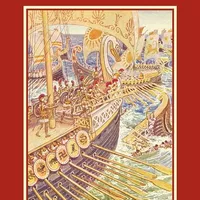29. Some Greek Colonies
"Hear, for thy children speak, from the uttermost parts of the sea." —KIPLING.
Now, while Greece was settling down after her warfare with Persia, let us take a glance at her possessions abroad and see how her children over the seas are getting on.
One of her largest and most important colonies was Cyrene, on the north coast of Africa, and opposite the southern point of Greece. It was one of the fairest spots on the face of the earth. Standing about ten miles from the sea, high above sea-level, it was sheltered from the hot blasts of the desert and open to the cool breezes of the Mediterranean, over whose blue waters it commanded a glorious view. Terraces—rich and fertile—stretched from mountain to shore. To the west her boundaries reached those of Carthage, being marked by the "Altar of the Philæni." A curious story is told of how the men of Carthage and the men of Cyrene agreed on their boundary. Carthage belonged to the Phœnicians and Cyrene to the Greeks, and these were rival Powers on the shores of the Mediterranean.
It was arranged that at a given time two men from each city should start, and the spot where they met, should be the boundary. The men of Carthage chose two brothers called the Philæni. They ran much faster than the Greeks of Cyrene, so that the Greeks accused them of starting before the appointed time. After some dispute the Greeks agreed to accept the spot as boundary, if the Philæni would consent to be buried alive, at this very spot in the sand. The brothers bravely agreed, for their country's sake, to suffer death; they were accordingly buried alive in the sand, in the full vigour of their manhood. Their grateful countrymen erected the altar to their memory. It was known as the Altar of the Philæni.
But still more important than Cyrene, was the Greek colony of Syracuse, the capital of Sicily—the old legendary land of the Cyclops—known to the ancients, as Greater Greece.
The great haven of Syracuse, with its island and its hill, occupied the most striking site on the east coast of Sicily, and could not fail to invite early colonists. So, three hundred years before this, the Greeks had driven out the Phœnicians, who had a station there, and now it was one of their most thriving colonies. Like the colonists at Cyrene, the "lord" of Syracuse sent his racehorses and chariots to contend in the great games at Olympia, and the Grecian poets wrote odes in honour of Sicilian victories. Possessing such a fine harbour, this colony of Syracuse had her own ships.
Let us see what these ships were like at this time. The early Greek warships were long and narrow, with twenty-five benches, on each of which sat two oarsmen,—that is to say, they were rowed by no less than fifty oars. Later the Greeks built their ships with two rows of benches, one above the other, so that the number of oarsmen and the speed could be increased without adding to the length of the ship.
But about this time the Phœnicians invented a new sort of ship, and the Greeks soon copied them. The new ship had three banks of oars, and was rowed by no less than one hundred and seventy men. This was the kind of ship that was used by the Greeks at the battle of Salamis. These "triremes," as they were called, had a square sail to be raised when the wind was favourable. Now the men of Syracuse invented an improvement to these triremes as warships. The old idea in naval warfare was to dash the pointed beak of the ship's front into the enemy's vessel, so cutting it in two and causing it to sink. The men of Syracuse made their beaks, or prows, of bronze, which was more effective, and it gave them the victory over the Phœnicians in the harbour of Syracuse.

